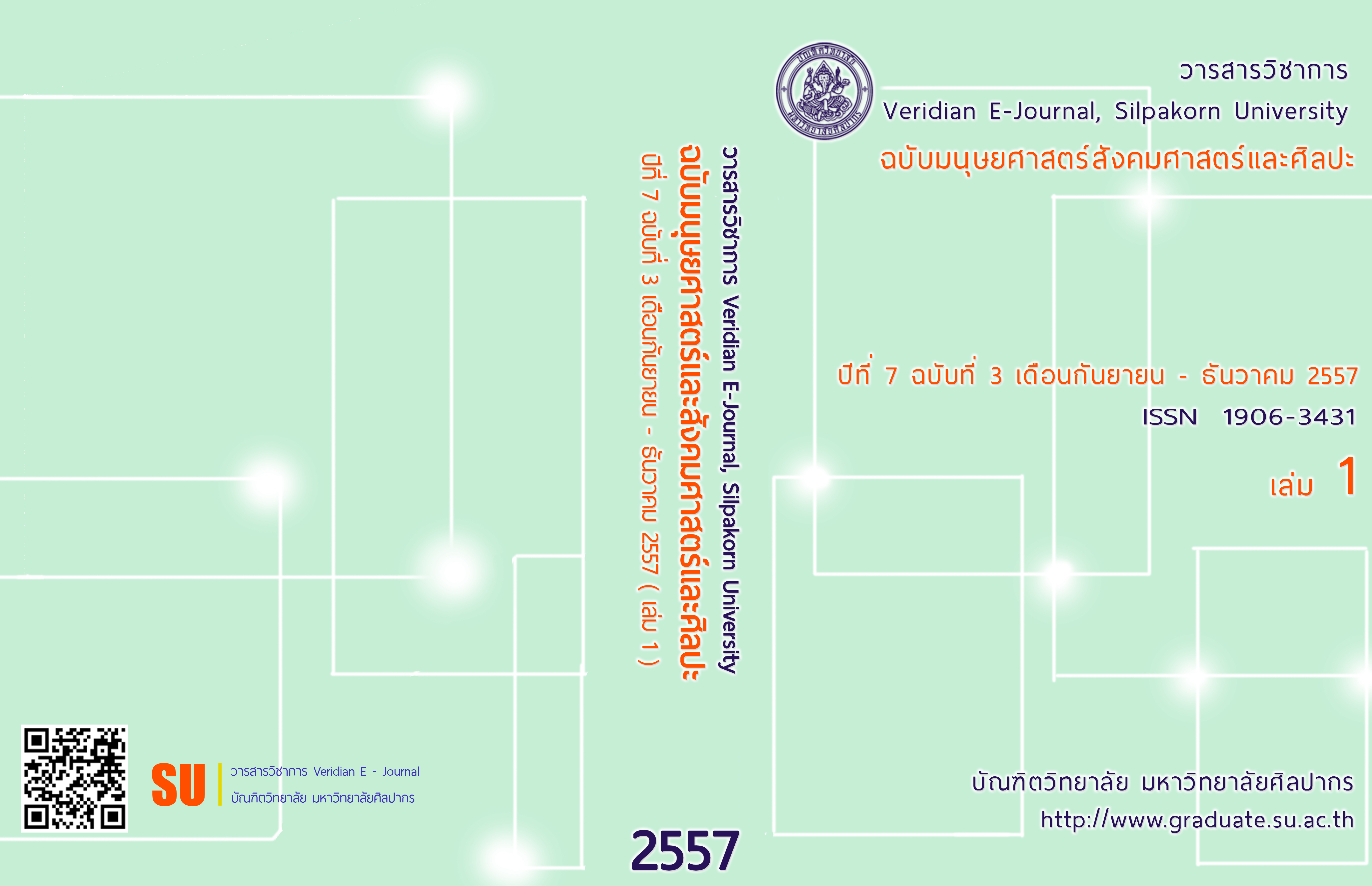ความต้องการบทเรียนอิเล็กทรอนิกส์เรื่องการออกแบบสื่อการศึกษาสร้างสรรค์สำหรับครู
Main Article Content
Abstract
บทคัดย่อ
การวิจัยครั้งนี้มีวัตถุประสงค์เพื่อความต้องการเกี่ยวกับการพัฒนาบทเรียนอิเล็กทรอนิกส์เรื่องการออกแบบสื่อการศึกษาสร้างสรรค์สำหรับครู เครื่องมือที่ใช้ในการวิจัยครั้งนี้ คือ แบบสอบถามความคิดเห็นของข้าราชการครูและบุคลากรทางการศึกษา เกี่ยวกับเนื้อหาที่ใช้ในบทเรียนอิเล็กทรอนิกส์ และการออกแบบบทเรียนอิเล็กทรอนิกส์ กลุ่มตัวอย่างในการวิจัย ได้แก่ ข้าราชการครูและบุคลากรทางการศึกษา ในโรงเรียนสังกัดสำนักงานเขตพื้นที่การศึกษาประถมศึกษากรุงเทพมหานคร จำนวน 300 คน โดยการสุ่มแบบแบ่งชั้นภูมิตามขนาดโรงเรียน (Stratified Random Sampling) วิเคราะห์ข้อมูลโดยใช้ความถี่ และร้อยละ
ผลการวิจัย พบว่า
1. ความรู้ด้านการออกแบบสื่อการศึกษา พบว่า กลุ่มตัวอย่างส่วนใหญ่มีความรู้ด้านการออกแบบสื่อการศึกษาระดับปานกลาง (ร้อยละ 64.00) ใช้สื่อประกอบการสอนประเภทสื่อกิจกรรม เช่น ชุดฝึกอบรม เกม ชุดฝึกทักษะ (ร้อยละ 29.00) มึความรู้ด้านการออกแบบสื่อการศึกษามากที่สุด ได้แก่ สื่อประเภทสื่อสิ่งพิมพ์ เช่น แบบเรียน หนังสือ การ์ตูน แบบฝึกทักษะ (ร้อยละ 57.00) มึความรู้ด้านการออกแบบสื่อการศึกษาน้อยที่สุด ได้แก่ สื่อประเภทสื่อใหม่ เช่น Social Media, Virtual Education, m-learning (ร้อยละ 42.67) และต้องการพัฒนาการออกแบบสื่อการศึกษา ประเภทสื่อใหม่ เช่น Social Media, Virtual Education, m-learning (ร้อยละ 29.00) มากที่สุด
2. การออกแบบบทเรียนอิเล็กทรอนิกส์ แบ่งออกเป็นด้านเนื้อหา ด้านสี ตัวอักษร ภาพประกอบ เสียง และระบบนำทาง
การออกแบบบทเรียนอิเล็กทรอนิกส์ด้านเนื้อหา พบว่า กลุ่มตัวอย่างส่วนใหญ่ต้องการให้เนื้อหาของบทเรียนอิเล็กทรอนิกส์เรื่องการออกแบบสื่อการศึกษาสร้างสรรค์ ประกอบด้วย สื่อกับการศึกษาเชิงสร้างสรรค์ (ร้อยละ 28.40) ลักษณะเนื้อหาของบทเรียนอิเล็กทรอนิกส์เป็นภาพและเนื้อหา (ร้อยละ 41.33) การนำเสนอเนื้อหาในบทเรียนอิเล็กทรอนิกส์เพื่อกระตุ้นความสนใจเป็นแบบภาพเคลื่อนไหว (ร้อยละ 37.33) ลักษณะการนำเสนอเนื้อหาในบทเรียนอิเล็กทรอนิกส์เป็นการนำเสนอที่เนื้อหามีความชัดเจน ข้อความกระชับ เข้าใจง่าย (ร้อยละ 28.40) และคุณภาพเนื้อหาต้องนำเสนอข้อมูลครบถ้วน ตรงตามวัตถุประสงค์ (ร้อยละ 23.10) มากที่สุด
การออกแบบบทเรียนอิเล็กทรอนิกส์ด้านสี พบว่า กลุ่มตัวอย่างส่วนใหญ่ต้องการให้บทเรียนอิเล็กทรอนิกส์แสดงโทนสีเย็น เช่น ฟ้า น้ำเงิน ม่วง (ร้อยละ 59.67) พื้นหลังมีลักษณะเป็นโทนสี (ร้อยละ 49.67) พื้นหลังสีอ่อน ตัวอักษรสีเข้ม (ร้อยละ 75.00) และแสดงสีตัวอักษรในแต่ละหน้าจอ 2-3 สี (ร้อยละ 33.67)
การออกแบบบทเรียนอิเล็กทรอนิกส์ด้านตัวอักษร พบว่า กลุ่มตัวอย่างส่วนใหญ่ต้องการให้ตัวอักษรมีชนิดและขนาดมีความชัดเจนและอ่านง่าย (ร้อยละ 29.00) แต่ละหน้าจอของบทเรียนอิเล็กทรอนิกส์แสดงชนิดของตัวอักษร 2-3 ชนิด (ร้อยละ 36.33) ตัวอักษรของหัวเรื่องมีขนาด 24 พอยท์ขึ้นไป (ร้อยละ 34.00) ตัวอักษรของหัวเรื่องเป็นแบบไม่มีหัว (34.67) และตัวอักษรของเนื้อหาเป็นแบบมีหัว (ร้อยละ 44.67) มากที่สุด
การออกแบบบทเรียนอิเล็กทรอนิกส์ด้านภาพประกอบ พบว่า กลุ่มตัวอย่างส่วนใหญ่ต้องการให้บทเรียนอิเล็กทรอนิกส์แสดงภาพประกอบมีความเกี่ยวข้องหรือมีความสัมพันธ์กับเนื้อหา (ร้อยละ 23.31) มากที่สุด รองลงมา คือ มีขนาดไม่ใหญ่หรือจำนวนมากเกินไป (ร้อยละ 19.98) และมีขนาดที่เห็นได้ง่าย ไม่มีสีสันและลวดลายมากเกินไป (ร้อยละ 19.75) ตามลำดับ
การออกแบบบทเรียนอิเล็กทรอนิกส์ด้านเสียง พบว่า กลุ่มตัวอย่างส่วนใหญ่ต้องการให้มีเสียงประกอบในบทเรียนอิเล็กทรอนิกส์ที่เหมาะสมกับกลุ่มเป้าหมาย (ร้อยละ 27.70) ออกเสียงได้ชัดเจน มีการใช้เสียงสูงและต่ำ และตัวควบกล้ำที่ดี (ร้อยละ 31.40) มากที่สุด
การออกแบบบทเรียนอิเล็กทรอนิกส์ด้านระบบนำทาง พบว่า กลุ่มตัวอย่างส่วนใหญ่ต้องการให้จุดเชื่อมโยงภายในบทเรียนอิเล็กทรอนิกส์สามารถควบคุมการใช้ได้ง่ายและสะดวกที่สุด (ร้อยละ 17.60) รูปแบบและตำแหน่งที่ชี้การนำทางมีความสม่ำเสมอ (ร้อยละ 28.80) มากที่สุด
Abstract
The purpose of this research was to develop the electronic courseware for creative educational media for teachers. The research instrument used was the questionnaire used for asking teachers and educational personnel’s opinions on the content and design in the electronic courseware. The samples of this research were 300 teachers and educational personnel in schools under the Bangkok Office of Elementary Education Service Area by stratified random sampling. The statistical analysis employed were frequency and percentage.
The results of this research were as follow:
1. For the knowledge of educational media design, most of the samples had the knowledge of educational media design at moderate level (64%). There was the use of activity media such as training package, games, and skill training package (29%). The samples had the highest knowledge of designing printed media such as textbook, cartoon, and exercise (57%), whereas they had the lowest knowledge of designing innovative media such as social media, virtual education, and m-learning (42.67%). There was a need of developing educational media design in innovative media consisting of social media, virtual education, and m-learning at the highest level (29%).
2. The education media design was divided into six areas including content, colors, letters, illustration, sound, and navigation system.
Considering content in the electronic courseware design, the samples needed the content in the electronic courseware for creative educational media on creative media and education (28.40%), pictures and lessons on the electronic courseware (41.33%), Animation for motivation on the electronic courseware (37.33%), explicit, concise, and comprehensible content on the electronic courseware (28.40%) and content completely presented corresponding to the specified objectives (23.10%) at the highest level.
Considering colors used in the electronic courseware design, the samples needed cool tone colors in the electronic courseware including blue, dark blue, or purple (59.67%), background with tone of colors (49.67%), background with light colors and letters with dark colors (75%), and the letters with a few colors used on each page (33.67%)
Considering letters used in the electronic courseware design, the samples needed the fonts and size that are explicit and easy to read (29%), a few fonts used on each page in the electronic courseware (36.33%), the title with the size at least 24 points (34%), the title with the font without head of letters (34.67%), and the letters with head (44.67%) at the highest level.
Considering illustration in the electronic courseware design, the samples needed the illustration corresponding to the content (23.31%) at the highest level, along with appropriate size and number of pictures (19.98%), and obvious size, moderate colors and pattern of the pictures (19.75%)
Considering sound in the electronic courseware design, the samples needed the sound used appropriately for target learners (27.70%), and clear pronunciation, intonation, and compound consonants (31.40%) at the highest level.
Considering navigation system in the electronic courseware design, the samples needed the navigation in the lessons that was easy to link comfortably (17.60%), and the constant pattern and position of navigation (28.80%) at the highest level.
